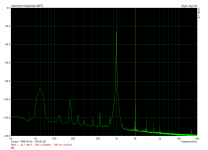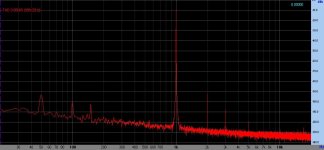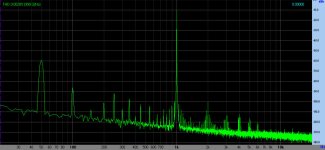Toroids should also have better leakage inductance than EIs, but EIs do have better PRI→SEC leakage capacitance than unscreened toroids, so they still have a place for some positions.
Looking around, another option is the Triad VPM series. These toroids are designed for medical applications, and have a primary-shield that can be connected to PE (earth). The screening brings a defined-maximum earth-leakage current of 10µA @264Vrms, so it should be <5µA for 120VAC Line.
There's a 240V rms secondary, the VPM240-420
VPM Series general lineup
They also have a custom windings page, so you should be able to get one for the Plate supply you need:
Triad Custom page
would be interesting to learn about anyone's experiences with these; but the low leakage current indicates likely good noise screening.
Triad (Perris, CA) still has at least some U.S. manufacturing; maybe that woud make custom PTs a practical option. It might well be worth giving them a call and giving them a target specification. After all, they do boast about history in Audio.
Looking around, another option is the Triad VPM series. These toroids are designed for medical applications, and have a primary-shield that can be connected to PE (earth). The screening brings a defined-maximum earth-leakage current of 10µA @264Vrms, so it should be <5µA for 120VAC Line.
There's a 240V rms secondary, the VPM240-420
VPM Series general lineup
They also have a custom windings page, so you should be able to get one for the Plate supply you need:
Triad Custom page
would be interesting to learn about anyone's experiences with these; but the low leakage current indicates likely good noise screening.
Triad (Perris, CA) still has at least some U.S. manufacturing; maybe that woud make custom PTs a practical option. It might well be worth giving them a call and giving them a target specification. After all, they do boast about history in Audio.
Thanks Rod.
The Triad VPM and Antek look quite similar in that they both have the shield that can be connected to earth. Comparable VA weight is more for the Antek's and the price roughly 50% less for the Antek. Also Antek has an additional 6.3V secondary winding while the Triad VPM does not. Anyway good to learn about the Triad option.
nash
The Triad VPM and Antek look quite similar in that they both have the shield that can be connected to earth. Comparable VA weight is more for the Antek's and the price roughly 50% less for the Antek. Also Antek has an additional 6.3V secondary winding while the Triad VPM does not. Anyway good to learn about the Triad option.
nash
Hey all, I have a question akin to the original question this thread was created for. A while back I bought a tube lot that had a pair of the weirdest 01A's I've ever seen. They are labeled as "Continental Electronic Co. Cetron CE-201-A". They are globe shaped, but are MUCH larger than standard globe 01As. They are even larger than my globe 45 tubes!
They also looked like they had condensation inside them, so for a while I just assumed they had a crack somewhere and were dead. However, looking at them again, that "condensation" is actually little beads of metal. I can get them to detach from the glass if I flick the tube. If I didn't know any better, I'd almost say that these are actually mercury vapor rectifiers. But I can't find anything online about these since they're labeled as 201A, and the only results I can find are for standard 201A tubes.
Attached is a few pics of them, as well as one comparing it to a globe 45 and standard globe 01A. Does anyone know for sure what this is?
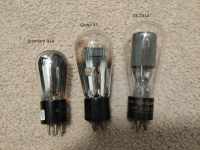
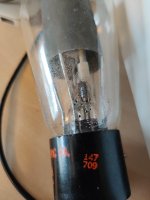
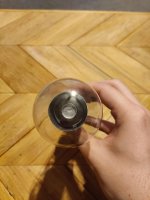
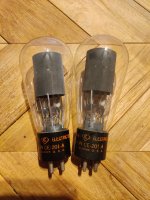
They also looked like they had condensation inside them, so for a while I just assumed they had a crack somewhere and were dead. However, looking at them again, that "condensation" is actually little beads of metal. I can get them to detach from the glass if I flick the tube. If I didn't know any better, I'd almost say that these are actually mercury vapor rectifiers. But I can't find anything online about these since they're labeled as 201A, and the only results I can find are for standard 201A tubes.
Attached is a few pics of them, as well as one comparing it to a globe 45 and standard globe 01A. Does anyone know for sure what this is?




Pretty sure its a mercury rectifier tube, see last page here..
https://www.google.ie/url?sa=t&rct=...-A-Tubes.pdf&usg=AOvVaw3Bav84zRLwxRvysjVumZdm
https://www.google.ie/url?sa=t&rct=...-A-Tubes.pdf&usg=AOvVaw3Bav84zRLwxRvysjVumZdm
Aha! Mystery solved. Thank you for finding that... I was really curious as to what they are. I didn't know there was a mercury tube with the same number as the common 201A. I definitely won't be plugging these into my 01A amp now!
You can do a couple of simple test to determine if they are or not vers of 01A.
Need a LV PS of abou 6V, One Amp. On the heater / filament terminals apply LV thru some kind of limiting restor
You will need a LV PS of about 12V, One Amp. I keep a discarded but still good auto battery under the bench for these kind of tests.
On the heater / filament terminals apply LV thru some kind of limiting resistor like 50R. If the filament is 5V, 0.25 A a VM across the filament terminals will settle at something like 3.5-4V. If the VM indicates much lower the tube is probably gassy & can’t warm up. Or might be a Hg rectifier.
If the tube passes that test, then apply 5V thru a suitable resistor to the filament. To check for gas apply ~100V thru a current limiting resistor of 100K to the plate while the grid is tied to the filament. If a VM connected to the plate settles at 8V you have a gas rectifier. Something like 50V might be a good indicator, you’ve got a tube that works.
Early members of the 01A family had One amp filaments until better cathode emission materials were developed.
For a very good account of how the 01A family & vacuum tubes in general were developed in vest in a copy of Gerald Tyne’s ‘Saga of the Vacuum Tube’.
Need a LV PS of abou 6V, One Amp. On the heater / filament terminals apply LV thru some kind of limiting restor
You can do a couple of simple tests to determine if those tubes are or not some vers of the 01A. Or DOA.Does anyone know for sure what this is?
You will need a LV PS of about 12V, One Amp. I keep a discarded but still good auto battery under the bench for these kind of tests.
On the heater / filament terminals apply LV thru some kind of limiting resistor like 50R. If the filament is 5V, 0.25 A a VM across the filament terminals will settle at something like 3.5-4V. If the VM indicates much lower the tube is probably gassy & can’t warm up. Or might be a Hg rectifier.
If the tube passes that test, then apply 5V thru a suitable resistor to the filament. To check for gas apply ~100V thru a current limiting resistor of 100K to the plate while the grid is tied to the filament. If a VM connected to the plate settles at 8V you have a gas rectifier. Something like 50V might be a good indicator, you’ve got a tube that works.
Early members of the 01A family had One amp filaments until better cathode emission materials were developed.
For a very good account of how the 01A family & vacuum tubes in general were developed in vest in a copy of Gerald Tyne’s ‘Saga of the Vacuum Tube’.
Attachments
I'm not sure that Continental Electronic Co. even made 01a/201a.
https://www.radiomuseum.org/dsp_hersteller_detail.cfm?company_id=7126
"condensation" is actually little beads of metal.
It seems mercury.
I only see mercury within mercury vapour rectifiers, so I'd be surprised if it is 201a.
https://www.radiomuseum.org/dsp_hersteller_detail.cfm?company_id=7126
"condensation" is actually little beads of metal.
It seems mercury.
I only see mercury within mercury vapour rectifiers, so I'd be surprised if it is 201a.
Yes, I believe it is mercury now as well. mcandmar posted a link above showing that CE made a mercury vapor rectifier that is labeled as 201A.It seems mercury.
I only see mercury within mercury vapour rectifiers, so I'd be surprised if it is 201a.
Listed at the top of the last page in the Radio Masters book as an Hg Rectifier..I'm not sure that Continental Electronic Co. even made 01a/201a.
Before much standardization of tube types was established many manufacturer's named their own to fit their offering. 🙄
I have been enjoying my two box 01A build with Ale's gyrator and Rod Coleman's V9 regs for some time.
I recently purchased a spare set of RCA UX201A tubes and installed them. Both tubes seem very good and adjusted similarly, but I cannot understand why the Left one pictured shows such a high 60hz peak. All the other tubes I have do not exhibit a peak like this and show up similar to the FFT of the Right tube. Switching positions between left and right makes no difference. If I shield the tube wiith my hand in a certain way THD+N seems to improve a bit.
Appreciate your thoughts.
Thanks. nash
I recently purchased a spare set of RCA UX201A tubes and installed them. Both tubes seem very good and adjusted similarly, but I cannot understand why the Left one pictured shows such a high 60hz peak. All the other tubes I have do not exhibit a peak like this and show up similar to the FFT of the Right tube. Switching positions between left and right makes no difference. If I shield the tube wiith my hand in a certain way THD+N seems to improve a bit.
Appreciate your thoughts.
Thanks. nash
Attachments
Thanks Euro21. I see you have run into something similar.
With no music and amps on max volume I hear no hum from the speakers; just the tube rush same on both sides.
Would this show up when I play some low bass music such as double bass? Practically, is it of any significance? Orchestral music played loud sounded just fine. BTW that is a 2v output FFT if that matters' comparing the height of H2 to the 60hz spike.
Any speculation as to why this tube is so sensitive?
nash
With no music and amps on max volume I hear no hum from the speakers; just the tube rush same on both sides.
Would this show up when I play some low bass music such as double bass? Practically, is it of any significance? Orchestral music played loud sounded just fine. BTW that is a 2v output FFT if that matters' comparing the height of H2 to the 60hz spike.
Any speculation as to why this tube is so sensitive?
nash
As you can see, the early tubes sometimes has open anode.
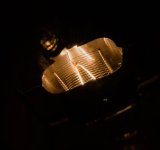
http://vinylsavor.blogspot.com/2013/10/tube-of-month-ux201a.html
Some of them induce radiated hum -via the grid wiring- , than another.
The precipitated getter (metal layer within the tube) acts as shield ... more or less ...
The early radio tubes sometimes has shield coating on outside.
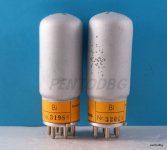

http://vinylsavor.blogspot.com/2013/10/tube-of-month-ux201a.html
Some of them induce radiated hum -via the grid wiring- , than another.
The precipitated getter (metal layer within the tube) acts as shield ... more or less ...
The early radio tubes sometimes has shield coating on outside.

Google is your friend. 😉
Unfortunately since it's AI "helped", the hit rate drastically deteriorated.
Unfortunately since it's AI "helped", the hit rate drastically deteriorated.
Those are nice and informative pics. Thank you.
In an effort to understand and isolate the 60hz spike issue with that tube I put an aluminum beer mug with a glass bottom over the tube, completely covering it. Kinda looked neat but unfortunately made no difference to the spike. Then I tried putting one of those copper/stainless saucepans over the tube. No difference.
BTW the tubes I have are the late manufactured ones with the nickel pins and shorter black base; I believe made before the switch to the ST type.
nash
In an effort to understand and isolate the 60hz spike issue with that tube I put an aluminum beer mug with a glass bottom over the tube, completely covering it. Kinda looked neat but unfortunately made no difference to the spike. Then I tried putting one of those copper/stainless saucepans over the tube. No difference.
BTW the tubes I have are the late manufactured ones with the nickel pins and shorter black base; I believe made before the switch to the ST type.
nash
Try aluminium folie (from kitchen). Wrap it and grounded to the preamp ground.
BTW tried to swap tubes?
If one filament supply is infected with hum, the "bad thing" stays on the same side. If not, it's the tube's speciality.
BTW tried to swap tubes?
If one filament supply is infected with hum, the "bad thing" stays on the same side. If not, it's the tube's speciality.
I wrapped some foil around a cardboard tube and slipped it over the tube. That made no difference. However, when I grounded the foil, as suggested by you, the 60hz spike disappeared! From a peak of -88db to -114db. Same result when I grounded the aluminum beer mug.
I have two switches on my power supply. The first one only supplies filament power. Switching this on causes most of the spike, switching on B+ increases it a bit more. Moving the tube to the other socket with a separate supply gives the same result. No other tube I have displays this behavior. So it is this tube specific.
Since most of the spike comes when the filament supply is turned on, where is this 60hz radiation from? Is this tube somehow hypersensitive to the very small AC from the filament supply and radiates it? Raw Power supply to the filaments is in a separate box connected by shielded umbilical.
Where can I buy a tube shield for a 01A? All the ones I see are for smaller tubes.
Thank you Bela/euro21 for your help in solving this.
nash
I have two switches on my power supply. The first one only supplies filament power. Switching this on causes most of the spike, switching on B+ increases it a bit more. Moving the tube to the other socket with a separate supply gives the same result. No other tube I have displays this behavior. So it is this tube specific.
Since most of the spike comes when the filament supply is turned on, where is this 60hz radiation from? Is this tube somehow hypersensitive to the very small AC from the filament supply and radiates it? Raw Power supply to the filaments is in a separate box connected by shielded umbilical.
Where can I buy a tube shield for a 01A? All the ones I see are for smaller tubes.
Thank you Bela/euro21 for your help in solving this.
nash
- Home
- Amplifiers
- Tubes / Valves
- 01A question

